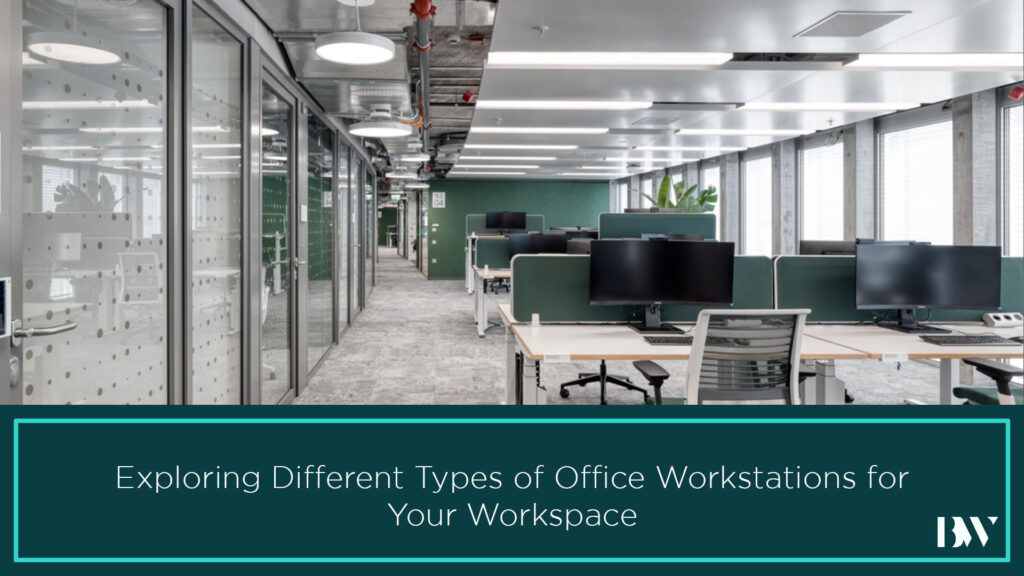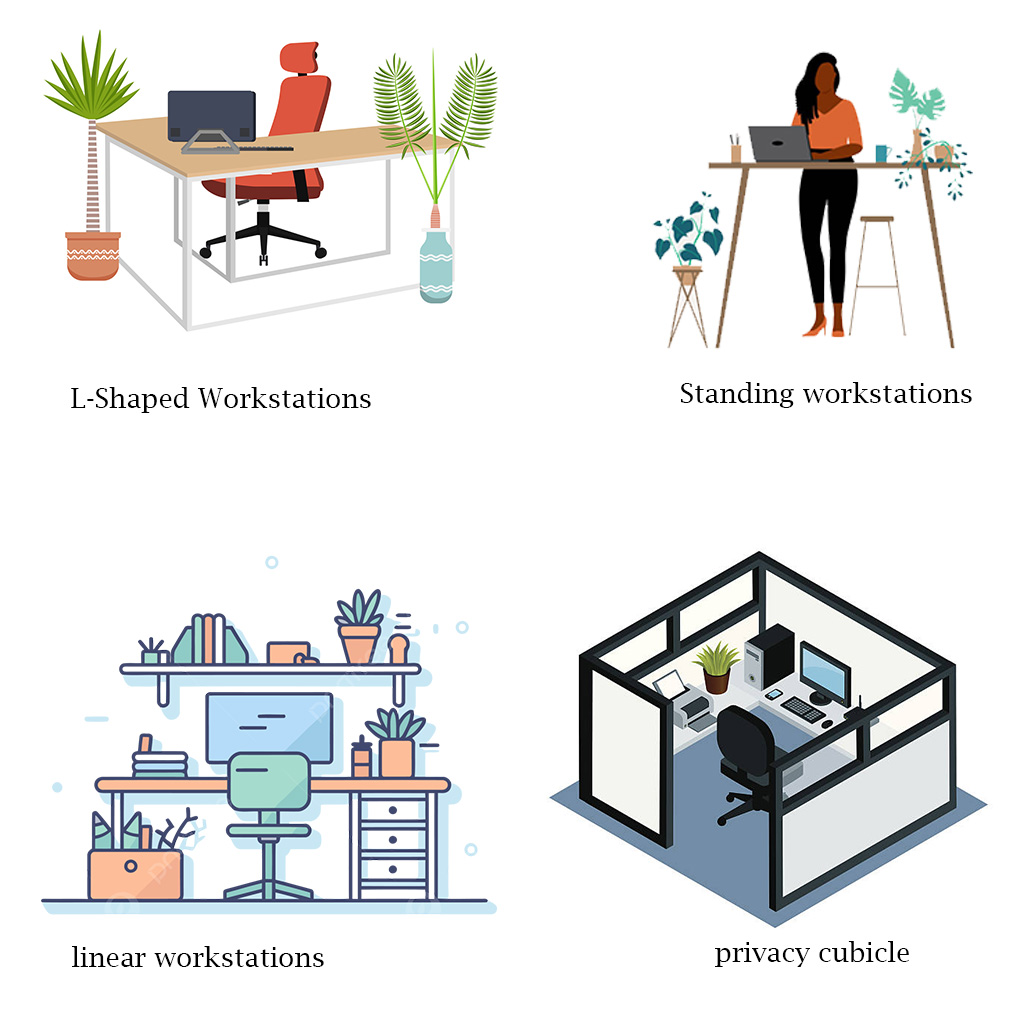Exploring Different Types of Office Workstations for Your Workspace

From classic cubicles, types of office workstations designs have evolved significantly. Since it has been demonstrated that a positive work environment increases employee productivity, businesses are now making an effort to make employees’ time there as joyful as possible.
It’s critical to examine the various styles of well-liked workstations that are sweeping the corporate world as the office evolves from a dull, frequently disregarded area to a hive of activity.
- Different Types of Office Workstations
- Types of Office Workstations
- Crucial Elements of Different Types of Office Workstations
Different Types of Office Workstations
One thing has dominated different types of office workstations since the creation of the desk and filing cabinet: space. More precisely, packing as many desks as possible into that area. Making the most of the available space to fit the greatest number of workers there was the only driving force. Thankfully, times and perspectives have evolved.
Businesses are attempting to make the time spent in the office as enjoyable as possible as they begin to realise that their employees are the company’s most valuable asset. Different types of office workstations are becoming more popular as the office transforms from a bland, effective torture chamber to a cozy, vibrant bay of productivity. The current focus is on employees and encouraging creativity and productivity. To find out more about the eleven different types of office workstations, keep reading this blog.
Types of Office Workstations:

1. Standing Workstations
Because standing for at least a portion of the workday may have health benefits, standing workstations have become more and more common recently. These standing workstations may have a footrest in addition to a surface for the keyboard and computer monitor that is higher.
2. Privacy Cubicles
These workstation types, which comprise a desk, chair, and storage cabinets, are the most prevalent ones. These modular types of office workstations with one seat are usually utilised in individual offices or cubicles. They’re excellent for maintaining privacy and could be a smart choice for offices handling private or sensitive data.
3. Ergonomic Workstations
The purpose of ergonomic workstations is to lessen physical strain while enhancing comfort and productivity. They could consist of seats, desks, and other furniture that can be adjusted to encourage good posture and lower the chance of injury.
These are typically workstation desks that are adjustable, which can assist relieve back pain, carpal tunnel syndrome, and other ailments brought on by extended periods of sitting.
4. Team Stations
The purpose of these cooperative types of office workstations is teamwork and collaboration. They might be placed in public spaces or special meeting rooms, and they might have a desk or table with space for several people to sit.
They can be found in a variety of sizes, forms, and layouts and often lack walls. In actuality, contemporary team stations feature bean bags in place of standard seats and a lively environment to improve strategy.
5. Hot Desks
Hot desks are adaptable types of office workstations that are available for use by any employee on a first-come, first-served basis. They are frequently used by co-working spaces and businesses with remote or mobile employees.
6. Cluster Workstations
Consider a workstation desk that is intended to promote communication and teamwork among several employees in a cluster. There you have it, too!
Every employee has their own private area and solitude, just like in cubicles, but they are also in close proximity to one another.
7. F3 Screen System Workstations
Workstations with an F3 screen system that offer support for accessories and cable management are available in several configuration options.
Workstations with F3 screen systems are adaptable in terms of panel height, available materials, and built-in storage choices. Indeed, they not only offer a cosy and well-organised desk, but they also increase staff productivity.
These workstations for offices are modular and adaptable. Desk units with built-in storage or desk-mounted screen-fitting options are available. You have two options for storage: a side multifunctional unit or a freestanding unit beneath the desk.
8. Linear Workstations
Workstations in a linear architecture are often grouped together in a single row. They can be arranged to suit particular situations and are usually placed side by side in a straight line.
Furthermore, staff can collaborate quickly on linear workstations. They are ideal in open-concept workplace designs.
9. L-Shaped Workstations
These classic workstations, shaped like the English letter L, are both comfortable and functional. The L-shaped desk set offers enough counter space for the monitor, extra screens, work-related activities, and accessories.
Usually, storage space is located underneath the L-shaped counter space. These workstations are spacious and simple to customise.
10. Four Seater Back to Back Workstation
Four workers can sit at this conventional workstation with their backs to one another. This creates a cluster with types of office workstations as well, giving each employee enough room and privacy.
11. Benching Stations
A large, open office with little to no designated personal space is what the benching concept offers. Workers are urged to pick up a laptop, choose a comfortable area to sit, and start working. Benching workstations with long, open tables and lots of sitting are like dining at a family-style restaurant. There are no privacy or partitions to encourage more candid discussion amongst colleagues.
Crucial Elements of Different Types of Office Workstations:
Now that you are aware of the many types of office workstations, let us quickly go over the essential components of a contemporary workstation:
- An ergonomic chair: A chair that accommodates the curvature of the spine will promote proper posture. Your feet should be allowed to rest flat on the floor or on a footrest if the chair height is adjustable. Additionally, the armrests have to be movable so that your shoulders can drop back and your arms can rest comfortably on them.
- An adjustable workstation desk: Should be sufficiently enough to fit all required office supplies, without being so big as to take up excessive room or make it hard to access objects at the back of the desk.
- Good lighting: To lessen eye strain and encourage attentiveness, the desk area should have good lighting. While natural lighting is ideal, the workstation should have the appropriate task lighting if this is not possible.
- Cable management: Appropriate cable management at the workstation area will help to minimise clutter and trip hazards. To fasten cables and wires to the wall and desk, use cable ties or clips.
- Adequate storage: Ample storage space on the desk is required for essentials like office supplies, files, and paperwork. Shelves, filing cabinets, and drawers can all be examples of this.
Conclusion
At Boardwalk India for Business, our workstation interior designers are always trying to implement the best practices for your office spaces that prioritise functionality and productivity. If you are looking for a partner to help you with best practices in different types of office workstations, simply contact us. Check out our website to learn more about types of office workstations – www.boardwalkindia.com
